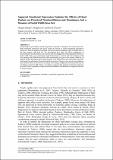Apparent emotional expression explains the effects of head posture on perceived trustworthiness and dominance, but a measure of facial width does not
Abstract
Interpreting the personality and the disposition of people is important for social interaction. Both emotional expression and facial width are known to affect personality perception. Moreover, both the apparent emotional expression and the apparent width-to-height ratio of the face change with head tilt. We investigated how head tilt affects judgements of trustworthiness and dominance and whether such trait judgements reflect apparent emotion or facial width. Sixty-seven participants rated the dominance, emotion, and trustworthiness of 24 faces posing with different head tilts while maintaining eye gaze at the camera. Both the 30° up and 20° down head postures were perceived as less trustworthy and more dominant (less submissive) than the head-level posture. Change in perceived trustworthiness and submissiveness with head tilt correlated with change in apparent emotional positivity but not change in facial width. Hence, our analysis suggests that apparent emotional expression provides a better explanation of perceived trustworthiness and dominance compared with cues to facial structure.
Citation
Zhang , D , Lin , H & Perrett , D I 2020 , ' Apparent emotional expression explains the effects of head posture on perceived trustworthiness and dominance, but a measure of facial width does not ' , Perception , vol. Online First . https://doi.org/10.1177/0301006620909286
Publication
Perception
Status
Peer reviewed
ISSN
0301-0066Type
Journal article
Description
This research was supported by grants from the National Natural Science Foundation of China (No. 61602079; No.61632011) and the Humanity and Social Science Youth Foundation of Ministry of Education of China (No. 16YJCZH141).Collections
Items in the St Andrews Research Repository are protected by copyright, with all rights reserved, unless otherwise indicated.

